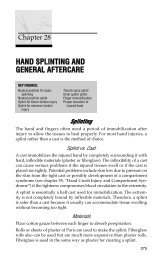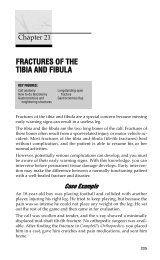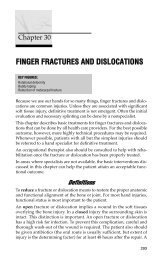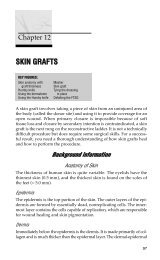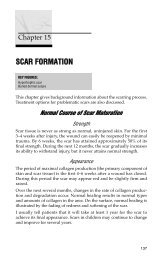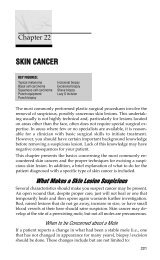- Page 1 and 2: Practical Plastic Surgery for Nonsu
- Page 3 and 4: Dedication To Chris and Jenny McCon
- Page 5 and 6: Table of Contents Chapter 1 Suturin
- Page 7: Contents vii Chapter 33 Nerve and V
- Page 10 and 11: Chapter 1 SUTURING: THE BASICS KEY
- Page 12 and 13: SSuuttuurree MMaatteerriiaall Sutur
- Page 14 and 15: Instruments Needed Suturing: The Ba
- Page 16 and 17: Placing the Sutures Suturing: The B
- Page 18 and 19: Interrupted or Continuous Closure A
- Page 20 and 21: The vertical mattress suture. Sutur
- Page 22 and 23: Figure-of-eight suture. This techni
- Page 26 and 27: Suturing: The Basics 17 Close the s
- Page 28 and 29: Suturing: The Basics 19 A, Closing
- Page 30 and 31: Chapter 2 BASIC SURGICAL TECHNIQUES
- Page 32 and 33: Basic Surgical Techniques 23 Make t
- Page 34 and 35: Regular Tie Basic Surgical Techniqu
- Page 36 and 37: Basic Surgical Techniques 27 that a
- Page 38 and 39: 30 Practical Plastic Surgery for No
- Page 40 and 41: 32 Practical Plastic Surgery for No
- Page 42 and 43: 34 Practical Plastic Surgery for No
- Page 44 and 45: 36 Practical Plastic Surgery for No
- Page 46 and 47: 38 Practical Plastic Surgery for No
- Page 48 and 49: 40 Practical Plastic Surgery for No
- Page 50 and 51: 42 Practical Plastic Surgery for No
- Page 52 and 53: 44 Practical Plastic Surgery for No
- Page 54 and 55: 46 Practical Plastic Surgery for No
- Page 56 and 57: 48 Practical Plastic Surgery for No
- Page 58 and 59: 50 Practical Plastic Surgery for No
- Page 60 and 61: 52 Practical Plastic Surgery for No
- Page 62 and 63: 54 Practical Plastic Surgery for No
- Page 64 and 65: 56 Practical Plastic Surgery for No
- Page 66 and 67: 58 Practical Plastic Surgery for No
- Page 68 and 69: 60 Practical Plastic Surgery for No
- Page 70 and 71: 62 Practical Plastic Surgery for No
- Page 72 and 73: 64 Practical Plastic Surgery for No
- Page 74 and 75:
Chapter 7 GUNSHOT WOUNDS KEY FIGURE
- Page 76 and 77:
Gunshot Wounds 69 Feel for the dist
- Page 78 and 79:
Gunshot Wounds 71 loosely closed to
- Page 80 and 81:
74 Practical Plastic Surgery for No
- Page 82 and 83:
76 Practical Plastic Surgery for No
- Page 84 and 85:
78 Practical Plastic Surgery for No
- Page 86 and 87:
80 Practical Plastic Surgery for No
- Page 88 and 89:
82 Practical Plastic Surgery for No
- Page 90 and 91:
84 Practical Plastic Surgery for No
- Page 92 and 93:
86 Practical Plastic Surgery for No
- Page 94 and 95:
88 Practical Plastic Surgery for No
- Page 96 and 97:
Chapter 11 PRIMARY WOUND CLOSURE KE
- Page 98 and 99:
HHooww ttoo SSuuttuurree tthhee WWo
- Page 100 and 101:
Primary Wound Closure 95 If the wou
- Page 102 and 103:
Chapter 12 SKIN GRAFTS KEY FIGURES:
- Page 104 and 105:
Skin Grafts 99 alive for, at most,
- Page 106 and 107:
Procedure for Taking the Graft Skin
- Page 108 and 109:
Skin Grafts 103 blade edge. You may
- Page 110 and 111:
Skin Grafts 105 3. Scraping the wou
- Page 112 and 113:
Indications Skin Grafts 107 FTSGs a
- Page 114 and 115:
Skin Grafts 109 4. Keep the dressin
- Page 116 and 117:
112 Practical Plastic Surgery for N
- Page 118 and 119:
114 Practical Plastic Surgery for N
- Page 120 and 121:
116 Practical Plastic Surgery for N
- Page 122 and 123:
118 Practical Plastic Surgery for N
- Page 124 and 125:
120 Practical Plastic Surgery for N
- Page 126 and 127:
122 Practical Plastic Surgery for N
- Page 128 and 129:
124 Practical Plastic Surgery for N
- Page 130 and 131:
126 Practical Plastic Surgery for N
- Page 132 and 133:
128 Practical Plastic Surgery for N
- Page 134 and 135:
130 Practical Plastic Surgery for N
- Page 136 and 137:
132 Practical Plastic Surgery for N
- Page 138 and 139:
134 Practical Plastic Surgery for N
- Page 140 and 141:
Chapter 15 SCAR FORMATION KEY FIGUR
- Page 142 and 143:
MMeetthhoodd ooff WWoouunndd CClloo
- Page 144 and 145:
Scar Formation 141 How to use the s
- Page 146 and 147:
Scar Formation 143 area may become
- Page 148 and 149:
Chapter 16 FACIAL LACERATIONS KEY F
- Page 150 and 151:
Facial Lacerations 147 Bupivacaine
- Page 152 and 153:
Suture Removal Facial Lacerations 1
- Page 154 and 155:
Facial Lacerations 151 1. It often
- Page 156 and 157:
Skin Facial Lacerations 153 • It
- Page 158 and 159:
Full-thickness Forehead Lacerations
- Page 160 and 161:
Anterior Side of the Ear Facial Lac
- Page 162 and 163:
BBiibblliiooggrraapphhyy Facial Lac
- Page 164 and 165:
162 Practical Plastic Surgery for N
- Page 166 and 167:
164 Practical Plastic Surgery for N
- Page 168 and 169:
166 Practical Plastic Surgery for N
- Page 170 and 171:
168 Practical Plastic Surgery for N
- Page 172 and 173:
170 Practical Plastic Surgery for N
- Page 174 and 175:
172 Practical Plastic Surgery for N
- Page 176 and 177:
174 Practical Plastic Surgery for N
- Page 178 and 179:
176 Practical Plastic Surgery for N
- Page 180 and 181:
178 Practical Plastic Surgery for N
- Page 182 and 183:
180 Practical Plastic Surgery for N
- Page 184 and 185:
Chapter 19 SOFT TISSUE INFECTIONS S
- Page 186 and 187:
Soft Tissue Infections 185 Cuts fro
- Page 188 and 189:
Soft Tissue Infections 187 1. Remin
- Page 190 and 191:
Soft Tissue Infections 189 Temporiz
- Page 192 and 193:
192 Practical Plastic Surgery for N
- Page 194 and 195:
194 Practical Plastic Surgery for N
- Page 196 and 197:
196 Practical Plastic Surgery for N
- Page 198 and 199:
198 Practical Plastic Surgery for N
- Page 200 and 201:
200 Practical Plastic Surgery for N
- Page 202 and 203:
202 Practical Plastic Surgery for N
- Page 204 and 205:
204 Practical Plastic Surgery for N
- Page 206 and 207:
206 Practical Plastic Surgery for N
- Page 208 and 209:
208 Practical Plastic Surgery for N
- Page 210 and 211:
210 Practical Plastic Surgery for N
- Page 212 and 213:
212 Practical Plastic Surgery for N
- Page 214 and 215:
214 Practical Plastic Surgery for N
- Page 216 and 217:
216 Practical Plastic Surgery for N
- Page 218 and 219:
218 Practical Plastic Surgery for N
- Page 220 and 221:
Chapter 22 SKIN CANCER KEY FIGURES:
- Page 222 and 223:
Skin Cancer 223 Most melanomas aris
- Page 224 and 225:
Skin Cancer 225 History of sun expo
- Page 226 and 227:
How to Do the Biopsy Skin Cancer 22
- Page 228 and 229:
Skin Cancer 229 approach is especia
- Page 230 and 231:
Skin Cancer 231 Performing a shave
- Page 232 and 233:
Re-excision for Melanoma Skin Cance
- Page 234 and 235:
Chapter 23 CLEFT LIP/PALATE KEY FIG
- Page 236 and 237:
PPrreesseennttaattiioonn aanndd IIn
- Page 238 and 239:
Helpful Strategies Cleft Lip/Palate
- Page 240 and 241:
Optimally, a pediatric dentist or o
- Page 242 and 243:
Cleft Lip/Palate 243 palate forms t
- Page 244 and 245:
246 Basic Surgical Procedures for t
- Page 246 and 247:
248 Basic Surgical Procedures for t
- Page 248 and 249:
250 Basic Surgical Procedures for t
- Page 250 and 251:
252 Practical Plastic Surgery for N
- Page 252 and 253:
254 Practical Plastic Surgery for N
- Page 254 and 255:
256 Practical Plastic Surgery for N
- Page 256 and 257:
258 Practical Plastic Surgery for N
- Page 258 and 259:
260 Practical Plastic Surgery for N
- Page 260 and 261:
262 Practical Plastic Surgery for N
- Page 262 and 263:
264 Practical Plastic Surgery for N
- Page 264 and 265:
266 Practical Plastic Surgery for N
- Page 266 and 267:
268 Practical Plastic Surgery for N
- Page 268 and 269:
270 Practical Plastic Surgery for N
- Page 270 and 271:
272 Practical Plastic Surgery for N
- Page 272 and 273:
Chapter 28 HAND SPLINTING AND GENER
- Page 274 and 275:
Hand Splinting and General Aftercar
- Page 276 and 277:
Splinting the hand with an extensor
- Page 278 and 279:
Hand Splinting and General Aftercar
- Page 280 and 281:
Chapter 29 FINGERTIP AND NAIL BED I
- Page 282 and 283:
Treatment Fingertip and Nail Bed In
- Page 284 and 285:
Subungual Hematoma Fingertip and Na
- Page 286 and 287:
Fingertip and Nail Bed Injuries 289
- Page 288 and 289:
Nail bed lacerations are often mult
- Page 290 and 291:
294 Practical Plastic Surgery for N
- Page 292 and 293:
296 Practical Plastic Surgery for N
- Page 294 and 295:
298 Practical Plastic Surgery for N
- Page 296 and 297:
300 Practical Plastic Surgery for N
- Page 298 and 299:
Chapter 31 TRAUMATIC HAND AND FINGE
- Page 300 and 301:
Traumatic Hand and Finger Amputatio
- Page 302 and 303:
Chapter 32 TENDON INJURIES OF THE H
- Page 304 and 305:
Repair of the Extensor Tendon Tendo
- Page 306 and 307:
Tendon Injuries of the Hand 311 Spl
- Page 308 and 309:
Chapter 33 NERVE AND VASCULAR INJUR
- Page 310 and 311:
Nerve and Vascular Injuries of the
- Page 312 and 313:
Nerve and Vascular Injuries of the
- Page 314 and 315:
Nerve and Vascular Injuries of the
- Page 316 and 317:
322 Practical Plastic Surgery for N
- Page 318 and 319:
324 Practical Plastic Surgery for N
- Page 320 and 321:
326 Practical Plastic Surgery for N
- Page 322 and 323:
328 Practical Plastic Surgery for N
- Page 324 and 325:
330 Practical Plastic Surgery for N
- Page 326 and 327:
332 Practical Plastic Surgery for N
- Page 328 and 329:
334 Practical Plastic Surgery for N
- Page 330 and 331:
336 Practical Plastic Surgery for N
- Page 332 and 333:
338 Practical Plastic Surgery for N
- Page 334 and 335:
340 Practical Plastic Surgery for N
- Page 336 and 337:
342 Practical Plastic Surgery for N
- Page 338 and 339:
344 Practical Plastic Surgery for N
- Page 340 and 341:
Chapter 37 SPECIFIC TYPES OF HAND I
- Page 342 and 343:
Specific Types of Hand Infections 3
- Page 344 and 345:
Specific Types of Hand Infections 3
- Page 346 and 347:
Specific Types of Hand Infections 3
- Page 348 and 349:
Chapter 38 CHRONIC HAND CONDITIONS
- Page 350 and 351:
Chronic Hand Conditions 357 On phys
- Page 352 and 353:
Chronic Hand Conditions 359 of the
- Page 354 and 355:
Chronic Hand Conditions 361 The car
- Page 356 and 357:
Chronic Hand Conditions 363 Also, u
- Page 358 and 359:
Chronic Hand Conditions 365 gentle
- Page 360 and 361:
Chapter 39 EXPLORATION OF AN INJURE
- Page 362 and 363:
Exploration of an Injured Hand or F
- Page 364 and 365:
Proper placement of incisions is im
- Page 366 and 367:
Dorsal Surface Exploration of an In
- Page 368 and 369:
Index Page numbers in boldface type
- Page 370 and 371:
Burns (cont.) subsequent care for,
- Page 372 and 373:
Dressings (cont.) wet-to-wet, 83 an
- Page 374 and 375:
Fractures (cont.) of fingers, 63, 2
- Page 376 and 377:
Instruments sharp disposal of, 47 s
- Page 378 and 379:
Nutritional support, for burn patie
- Page 380 and 381:
Shotgun injuries, 71 Silicone breas
- Page 382 and 383:
Tendon injuries (cont.) traumatic a




